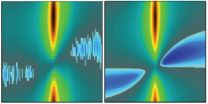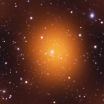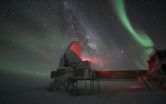(Press-News.org)
VIDEO:
This animation shows how large numbers of stars form in the Phoenix Cluster. It begins by showing several galaxies in the cluster and hot gas (in red). This hot gas...
Click here for more information.
Astronomers have found an extraordinary galaxy cluster, one of the largest objects in the universe, that is breaking several important cosmic records. Observations of the Phoenix cluster with NASA's Chandra X-ray Observatory, the National Science Foundation's South Pole Telescope, and eight other world-class observatories may force astronomers to rethink how these colossal structures and the galaxies that inhabit them evolve.
Stars are forming in the Phoenix cluster at the highest rate ever observed for the middle of a galaxy cluster. The object also is the most powerful producer of X-rays of any known cluster and among the most massive. The data also suggest the rate of hot gas cooling in the central regions of the cluster is the largest ever observed.
The Phoenix cluster is located about 5.7 billion light years from Earth. It is named not only for the constellation in which it is located, but also for its remarkable properties.
"While galaxies at the center of most clusters may have been dormant for billions of years, the central galaxy in this cluster seems to have come back to life with a new burst of star formation," said Michael McDonald, a Hubble Fellow at the Massachusetts Institute of Technology and the lead author of a paper appearing in the Aug. 16 issue of the journal Nature. "The mythology of the Phoenix, a bird rising from the dead, is a great way to describe this revived object."
Like other galaxy clusters, Phoenix contains a vast reservoir of hot gas, which itself holds more normal matter -- not dark matter -- than all of the galaxies in the cluster combined. This reservoir can be detected only with X-ray telescopes such as Chandra. The prevailing wisdom once had been that this hot gas should cool over time and sink to the galaxy at the center of the cluster, forming huge numbers of stars. However, most galaxy clusters have formed very few stars during the last few billion years. Astronomers think the supermassive black hole in the central galaxy of a cluster pumps energy into the system, preventing cooling of gas from causing a burst of star formation.
The famous Perseus cluster is an example of a black hole bellowing out energy and preventing the gas from cooling to form stars at a high rate. Repeated outbursts in the form of powerful jets from the black hole in the center of Perseus created giant cavities and produced sound waves with an incredibly deep B-flat note 57 octaves below middle C, which, in turn, keeps the gas hot.
"We thought that these very deep sounds might be found in galaxy clusters everywhere," said co-author Ryan Foley, a Clay Fellow at the Harvard-Smithsonian Center for Astrophysics in Cambridge, Mass. "The Phoenix cluster is showing us this is not the case -- or at least there are times the music essentially stops. Jets from the giant black hole at the center of a cluster are apparently not powerful enough to prevent the cluster gas from cooling."
With its black hole not producing powerful enough jets, the center of the Phoenix cluster is buzzing with stars that are forming about 20 times faster than in the Perseus cluster. This rate is the highest seen in the center of a galaxy cluster but not the highest seen anywhere in the universe. However, other areas with the highest star formation rates, located outside clusters, have rates only about twice as high.
The frenetic pace of star birth and cooling of gas in the Phoenix cluster are causing the galaxy and the black hole to add mass very quickly -- an important phase the researchers predict will be relatively short-lived.
"The galaxy and its black hole are undergoing unsustainable growth," said co-author Bradford Benson, of the University of Chicago. "This growth spurt can't last longer than about a hundred million years. Otherwise, the galaxy and black hole would become much bigger than their counterparts in the nearby universe."
Remarkably, the Phoenix cluster and its central galaxy and supermassive black hole are already among the most massive known objects of their type. Because of their tremendous size, galaxy clusters are crucial objects for studying cosmology and galaxy evolution, so finding one with such extreme properties like the Phoenix cluster is important.
"This spectacular star burst is a very significant discovery because it suggests we have to rethink how the massive galaxies in the centers of clusters grow," said Martin Rees of Cambridge University, a world-renowned expert on cosmology who was not involved with the study. "The cooling of hot gas might be a much more important source of stars than previously thought."
The Phoenix cluster originally was detected by the National Science Foundation's South Pole Telescope, and later was observed in optical light by the Gemini Observatory, the Blanco 4-meter telescope and Magellan telescope, all in Chile. The hot gas and its rate of cooling were estimated from Chandra data. To measure the star formation rate in the Phoenix cluster, several space-based telescopes were used, including NASA's Wide-field Infrared Survey Explorer and Galaxy Evolution Explorer and ESA's Herschel.
INFORMATION:
NASA's Marshall Space Flight Center in Huntsville, Ala., manages the Chandra Program for NASA's Science Mission Directorate in Washington. The Smithsonian Astrophysical Observatory controls Chandra's science and flight operations from Cambridge, Mass.
Phoenix cluster sets record pace at forming stars
2012-08-16
ELSE PRESS RELEASES FROM THIS DATE:
Researchers reveal behaviors of the tiniest water droplets
2012-08-16
A new study by researchers at the University of California, San Diego, and Emory University has uncovered fundamental details about the hexamer structures that make up the tiniest droplets of water, the key component of life – and one that scientists still don't fully understand.
The research, recently published in The Journal of the American Chemical Society (JACS), provides a new interpretation for experimental measurements as well as a vital test for future studies of our most precious resource. Moreover, understanding the properties of water at the molecular level ...
Record-breaking galaxy cluster discovered
2012-08-16
A massive galaxy cluster nearly six billion light years from Earth has been discovered with an astounding and unexpected burst of star formation – more prodigious than any galaxy cluster yet observed, an international team of astronomers and NASA announced today.
In a wide-ranging discussion on the eve of the announcement, two of the leading astronomers on the project talked about the record-breaking galaxy cluster, called Phoenix, and how its surprising properties are prompting astronomers to re-think how galaxy clusters – among the largest structures in the universe ...
Good vibrations
2012-08-16
A long-time staple of science fiction is the tractor beam, a technology in which light is used to move massive objects – recall the tractor beam in the movie Star Wars that captured the Millennium Falcon and pulled it into the Death Star. While tractor beams of this sort remain science fiction, beams of light today are being used to mechanically manipulate atoms or tiny glass beads, with rapid progress being made to control increasingly larger objects. Those who see major roles for optomechanical systems in a host of future technologies will take heart in the latest results ...
Team uncovers link between hormone levels and risk for metabolic disease
2012-08-16
JUPITER, FL, August 15, 2012 – Working with a national team of researchers, a scientist from the Florida campus of The Scripps Research Institute has shown for the first time a link between low levels of a specific hormone and increased risk of metabolic disease in humans.
The study, published online ahead of print in The Journal of Clinical Endocrinology & Metabolism, focuses on the hormone adropin, which was previously identified by Scripps Research Associate Professor Andrew Butler's laboratory during an investigation of obese and insulin-resistant mice. Adropin is ...
Giant galaxy cluster sets record pace for star creation
2012-08-16
Astronomers have found an extraordinary galaxy cluster — one of the largest objects in the universe — that is breaking several important cosmic records. The discovery of this cluster, known as the Phoenix Cluster, made with the National Science Foundation's South Pole Telescope, may force astronomers to rethink how these colossal structures, and the galaxies that inhabit them, evolve.
Follow-up observations made in ultraviolet, optical and infrared wavelengths show that stars are forming in this object at the highest rate ever seen in the middle of a galaxy cluster. The ...
Designing tiny molecules that glow in water to shed light on biological processes
2012-08-16
CORAL GABLES, FL (August, 15, 2012)--University of Miami scientists have developed a way to switch fluorescent molecules on and off within aqueous environments, by strategically trapping the molecules inside water-soluble particles and controlling them with ultraviolet light. The new system can be used to develop better fluorescent probes for biomedical research.
Previous studies have used water-soluble particles to bring organic molecules into water. What is novel about this system is the use of a photoswitching mechanism in combination with these particles.
The findings ...
NSF's South Pole Telescope discovers a galaxy cluster creating stars at a record pace
2012-08-16
A National Science Foundation-funded radio telescope in Antarctica has found an extraordinary galaxy cluster that may force astronomers to rethink how galaxy clusters and the galaxies that inhabit them evolve.
The galaxy cluster was discovered some 5.7 billion light years from Earth by the 10-meter wide South Pole Telescope (SPT) located at NSF's Amundsen-Scott South Pole Station in Antarctica, which is funded by NSF's Office of Polar Programs.
NSF manages the U.S. Antarctic Program, through which it coordinates all U.S research and required logistical support on the ...
Lunar reconnaissance orbiter spectrometer detects helium in moon's atmosphere
2012-08-16
Scientists using the Lyman Alpha Mapping Project (LAMP) spectrometer aboard NASA's Lunar Reconnaissance Orbiter (LRO) have made the first spectroscopic observations of the noble gas helium in the tenuous atmosphere surrounding the Moon.
These remote-sensing observations complement in situ measurements taken in 1972 by the Lunar Atmosphere Composition Experiment (LACE) deployed by Apollo 17.
Although designed to map the lunar surface, the LAMP team expanded its science investigation to examine the far ultraviolet emissions visible in the tenuous atmosphere above the ...
NASA sees large Tropical Storm Kai-tak headed for a landfall near Hong Kong
2012-08-16
Warnings are still in effect in the northern Philippines and now in Hong Kong, as Tropical Storm Kai-tak continues to drop heavy rainfall and move toward a landfall in China. NASA's Aqua satellite captured infrared data that shows a large area of strong thunderstorms that make up Kai-tak.
NASA's Aqua satellite captured infrared data on Kai-tak when it passed overhead on August 15 at 0517 UTC (1:17 a.m. EDT/1:17 p.m. local time, Hong Kong). Forecasters at the Joint Typhoon Warning Center noted that infrared satellite imagery shows the organization near the center of Kai-tak's ...
Lunar Reconnaissance Orbiter's LAMP spectrometer detects helium in moon's atmosphere
2012-08-16
Scientists using the Lyman Alpha Mapping Project (LAMP) aboard NASA's Lunar Reconnaissance Orbiter have made the first spectroscopic observations of the noble gas helium in the tenuous atmosphere surrounding the Moon. These remote-sensing observations complement in-situ measurements taken in 1972 by the Lunar Atmosphere Composition Experiment (LACE) deployed by Apollo 17.
Although LAMP was designed to map the lunar surface, the team expanded its science investigation to examine the far ultraviolet emissions visible in the tenuous atmosphere above the lunar surface, detecting ...







